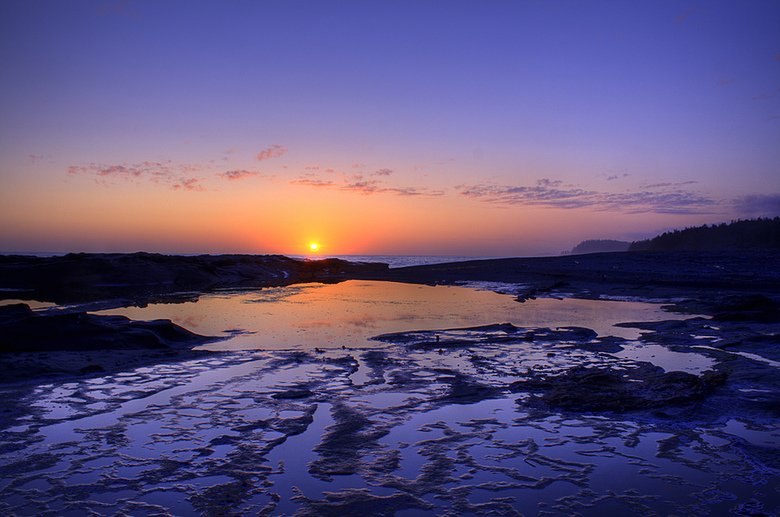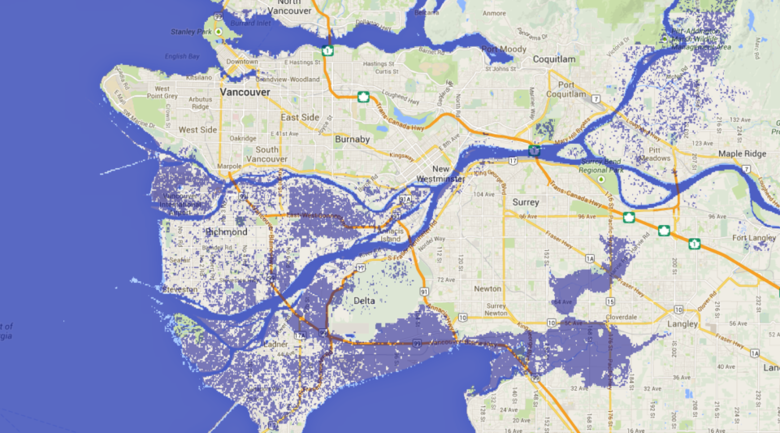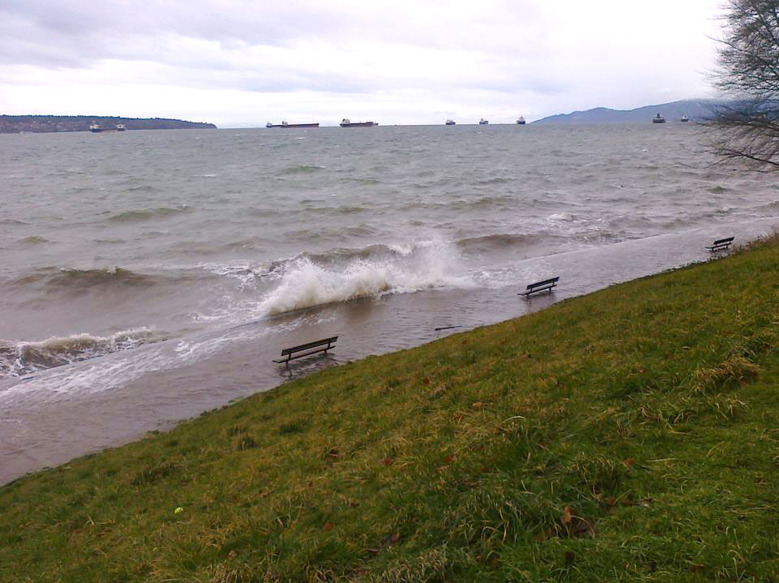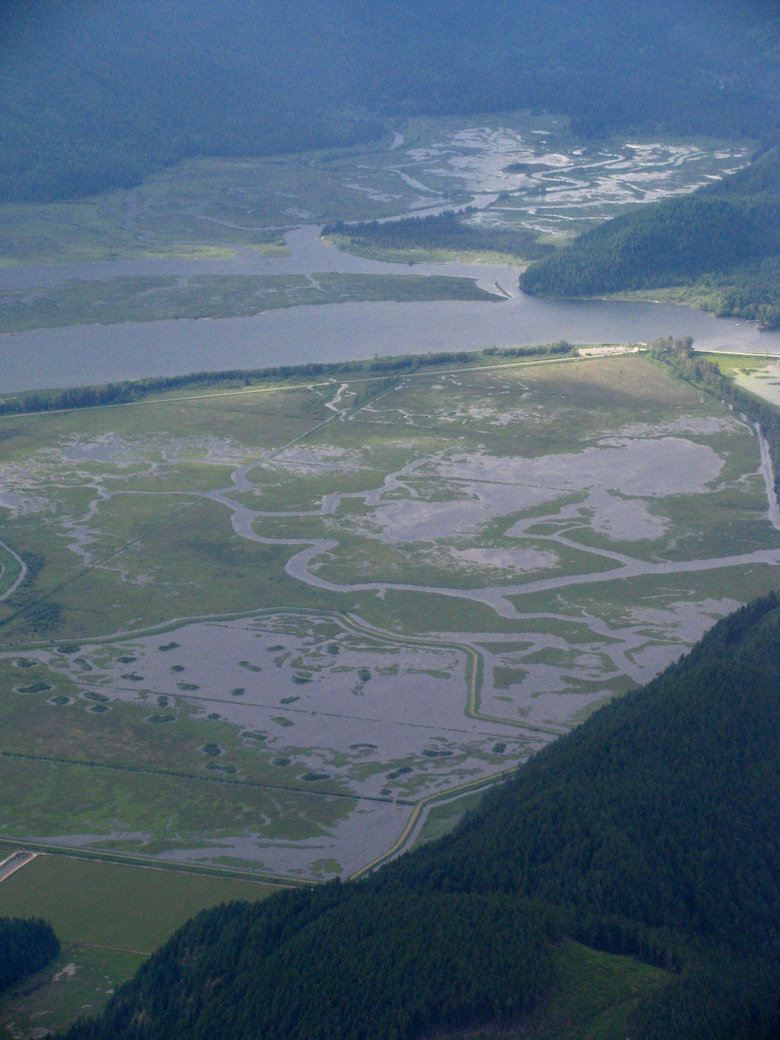Vancouver: a picturesque modern city on the ocean's edge. Snow capped mountains and sandy beaches characterize the picturesque young city. Many people come to the Vancouver area to enjoy its natural beauty and clean air, and the city prides itself on its image as a green city. Many of these people come from overseas, trying to escape rising air pollution and health risks in their own countries. But as Vancouver is coastal city in the era of climate change, some people are concerned about the city's future.
 Vanouver Coal Harbor By Evan Leeson
Vanouver Coal Harbor By Evan Leeson
Global warming is melting ice around the world, contributing to further warming and raising sea levels. As senior NASA scientist Stefan Rahmstorf put it in a recent article for the United Nations Office for the Co-ordination of Humanitarian Affairs:
Once set in motion, sea-level rise is impossible to stop. The only chance we have to limit sea-level rise to manageable levels (say, one metre, which is severe enough) is to reduce emissions very quickly, early in this century. Later it will be too late to do much.
Just how severe the sea level rise will be will vary from one place to another. Poorer areas will have a much harder time financing the infrastructure needed to adapt to the rising tides than affluent regions, and local geography will play a big role. A 1 metre sea level rise could displace 7 million people in Vietnam alone, and small Pacific islands are already feeling the devastating impacts of a rising sea.
Things are changing fast. As one eminent climate scientist has put it, "Since the 1950s, many of the observed changes are unprecedented over decades to millennia." Will we be able to adapt, or is metro Vancouver doomed to sink beneath the waves?
With a strong economy and a mild climate, Vancouver itself is in some ways well situated to face the challenges of a changing climate. However, Vancouver is also a coastal city which has been identified in a recent CBC article as among the top 20 major cities at risk. The beautiful coastal landscape that is one of our most attractive features may also turn out to be our greatest vulnerability.
 Beautiful Coastal Landscape Near Vancouver By H2O Alchemist
Beautiful Coastal Landscape Near Vancouver By H2O Alchemist
Turning Tides
According to the Sea Level Rise Adaptation Primer commissioned by the BC Ministry of Environment, "Even if green house gas emissions halt tomorrow, the impacts of climate change will continue into the foreseeable future." The sea level has been rising about 3 millimetres per year since 1993 — about twice the speed of the previous two centuries. The Adaptation Primer recommends we plan for a 1 metre sea level rise by 2100, and 0.5 metres by 2050. This is considerably higher than the most recent IPCC report predicts. However, even though the 2013 IPPC report's predictions are quite a bit higher than their controversial predictions in 2007, many scientists think the new numbers are still too conservative. According to SFU's Adaptation to Climate Change Team (ACT), predictions range from sea levels rising 18 centimetres to 2 metres by the end of this century. The IPCC's predictions make up the bottom end of this spectrum. This tool has been developed to help give people an idea of how a given sea level rise would affect a certain area.
 A 2 meter sea level rise simulation highlights areas (blue overlay) which are under the sea level,
A 2 meter sea level rise simulation highlights areas (blue overlay) which are under the sea level,
thus in greater danger of flooding.
The Executive Director of ACT, Deborah Harford, is an expert on climate change adaptation strategies. The organization she heads advises all levels of government and works to build connections between researchers, NGOs, industry representatives, and First Nations groups to find strategies for coping with climate change. She points out,
In 2013, Vancouver was identified as one of the top cities in the world at risk from rising sea levels, based on the value of our exposed assets, including valuable waterfront properties. The world also faces increasingly severe and extended extreme weather events caused by climate change, such as intense precipitation that can cause flash flooding. When you combine these challenges with the region's vulnerability to Fraser River flooding in the spring freshet, it becomes clear that homeowners and business leaders alike have a clear incentive to include climate change in their assessment of capital risk.
For most people, their house isn't only their largest capital investment, but also their home — the place where they set down roots and establish themselves in a community. As Deborah puts it, "Realtors are on the front lines of assisting buyers in understanding their investment strategies, often for the largest purchases they will make in their lifetimes. As understanding of these issues grows, realtors will become leaders in shaping a new, more resilient approach to asset investments in the Vancouver region." Both municipalities and homeowners have a role to play in building this resiliency.
 Graph: Sea Level in Vancouver Over Time
Graph: Sea Level in Vancouver Over Time
In 2013, both Calgary and Toronto were hit by extreme weather and flooding, costing each city hundreds of millions of dollars in damages. The damage done to New York City by Hurricane Sandy is staggering. As a coastal city, we could face a similar emergency, as the rising tides come with an increased probability of severe storms. But in the face of such uncertainty, it's important that we not defeated by fatalistic thinking. The changing climate will certainly have impact here, but are we in danger of being wiped off the map?
Adaptation: Infrastructure for the Future
When people talk about the impact of a rising sea level on Vancouver or Richmond, they often do so without taking adaptation strategies into consideration. If we sit idly by and do nothing as the sea levels rise, then Richmond and some areas of Vancouver will be in some trouble. But we're fortunate to live in an affluent region, and we have the resources to adapt to the changing seas.
Vancouver
Vancouver is the first Canadian city to adopt a Climate Change Adaptation Strategy. Key to this plan are building and improving defences to protect this vulnerable coastal city. The Ministry of Forests, Lands and Natural Resource Operations estimates the cost of improving dikes in the Metro Vancouver area to surpass $9 billion over the next century. And because all the funding for municipal infrastructure comes from property taxes,homeowners in the Lower Mainland can expect to be paying more on property taxes in the coming years.
 English Bay In Vancouver By Lisa
English Bay In Vancouver By Lisa
If no mitigating actions are taken, some areas would be at risk of flooding. Bing Tom Architects analyzed the economic impact of a sea level rise, and found that an unmitigated rise of 1 metre would cause losses of roughly $25 billion in real estate, affecting primarily industrial and agricultural land. They further estimate the cost of dike improvements to mitigate 1metre rise to be between $255 million and $500 million, not including land acquisition which could "go into the billions."
The Southlands, one of the most desirable luxury neighbourhoods in Vancouver, are at risk of flooding from the Fraser River. While there are some historic dikes here, they haven't been maintained and are inadequate. Strathcona, the oldest residential neighbourhood, has also been identified as at higher risk. False Creek would also be threatened unless we take spteps to protect it. Building dikes here would be a challenge, since they could have major impacts on the shoreline and existing properties. In addition to dikes, a $25 million sea gate that could close during storms has been proposed. While the costs of protecting these areas might seem high, when compared to $25 billion that could be lost by inaction, the cost of mitigation doesn't seem too bad.
A less obvious problem addressed by the Climate Change Adaption Strategy is our sewer system. Like many cities, Vancouver uses an outdated combined sewage system that collects waste water and storm water in the same pipe. The only way for this system to prevent sewage backing up during heavy rains into people's homes, businesses, and streets is for the sewers to overflow directly into the Fraser River. This isn't a very environmentally friendly solution. The City of Vancouver recognizes this risk as a key climate vulnerability, and it aims to eliminate the risk of combined sewage overflows by 2050. While the city goes about separating the main sewer lines, it expects homeowners to upgrade the sewer connection on their properties at their own expense. You can view this website to see which neighbourhoods have already been upgraded and which are in progress. Downtown, the West End, and Mount Pleasant already have been completed, while Shaughnessy, Point Grey, and Kitsilano are some of the neighbourhoods slated for completion by 2020.
Richmond
Richmond has its own set of challenges. It's well known that much of Richmond is below sea level, and some are convinced that this will be the city's doom. Richmond's is located about 1 metre above the current average sea level and is on a floodplain. This gives Richmond the rich soil which allows for it's beautiful gardens and farms, but also means a higher risk of flooding. However, Richmond has some advantages, too. In fact, because of the higher risk of flooding, Richmond is already protected by over 50 kilometres of dikes, 320 kilometres of canals, and 600 kilometres of culverts and storm sewers. Unlike the few dikes that Vancouver has, Richmond's dikes are regularly maintained and monitored. Plus, the city already has a flood prevention strategy in place up to 2031.
 The Fraser River at its Highest in 40 Years in June 2012 By Ryan
The Fraser River at its Highest in 40 Years in June 2012 By Ryan
That being said, we don't think that Richmond is doomed. Just consider the example of the Netherlands, where half the country is less than 1 metre above sea level, and where over 3 million people live below sea level. Ironically, Richmond may be better prepared than Vancouver to deal with a rising sea level precisely because the risk there is greater. People are already taking the risk of flood seriously, and systems are already in place. Of course, in order to stand up to the challenge of the rising seas, Richmond will need to continue improving it's defenses.
One of the more vulnerable areas, Steveston Village sits on the southern extremity of Richmond, right along the Fraser River. A historic fishing village, Steveston is one of the area's most charming neighbourhoods. Residents and visitors can be found strolling along the boardwalk that runs along the river's edge, and just beyond the boardwalk are lines of sleek new condos overlooking the water where active fishing vessels are moored. It's a picturesque place, with historic buildings and some of the city's best restaurants, all right by the shore. Currently, Steveston is protected by Shady Island, an artificial breakwater. To adapt to the challenges of climate change, Richmond is considering improving the barrier island and implementing a sea gate that can close when the weather gets tough. The provincial government estimates that this project would cost around $10 million. While it's not going to be cheap to keep Richmond's flood defences up to the task, the city isn't about to join Atlantis at the bottom of the sea.
Investing In the Future
Municipalities across Canada are preparing for the changing climate. Luckily, Vancouver and Richmond are at the forefront of these initiatives, and neither city is going to disappear beneath the waves - even assuming the more pessimistic predictons for a sea level rise.
That said, like all coastal cities, Vancouver is in for a bumpy ride. A tremendous amount of money will have to be spent over the coming decades to build the infrastructure required in order to protect Metro Vancouver from storm surges and the rising tide. Realistically, we aren't facing an existential crisis as much as an economical one. With so much of our economy tied to the port, coastal industries and tourism, the costs of adaptation will be high. But the question isn't so much "can we afford to-" as "can we afford not to-?"
If you can't beat it...
If you're looking for a new home in Vancouver but feeling particularly uneasy about the rising tides, there's one peculiar solution. Instead of keeping the water out of your home, you could consider putting your home on the water. For decades, some unconventional Vancouverites have been living afloat in homes moored off Granville Island and Coal Harbour. Even though there are only a handful of these homes in and around Vancouver, they have become something of a city icon and are growing in popularity. Unlike houseboats, these float homes don't have motors, and the only moving they do is on the ebbs and flows of the sea. While floating homes may seem like a bit of a fad, Finn Slough in Richmond has had homes on the water since the 1800s! Of course, this lifestyle isn't for everyone, and it can be quite expensive. The homes themselves range between $200,000 and $1 million, on top of which you can expect to pay moorage fees, city taxes, marine insurance, and strata fees. But you won't have to worry about your basement flooding.
DSMCJA





Currently richmond is studying a $200~ million upgrade to our existing dyke system. Most likely they will proceed which will see an upgrade to the entire system. As bad you dislike us, we’re here to stay bro.
There’s no hate in this. Most likely it will cost the city much more, but it’s here to stay. It just means you’ll have to do proper research over in Netherlands ;)
Dutch and Japanese companies stand to make a fortune in the coming decades providing expertise and systems to nations facing rising sea levels.
A large earthquake is a much greater risk for Richmond. The city is built on 1000 foot thick layer of peat and sand. Some buildings I have to wonder about if the shaking gets going….
I always wondered why Richmond turned into a nice neighbourhood. I remember it being looked down upon before the mid 90s. Usually wealthy people don’t move to areas that are literally built on sand.
“I always wondered why Richmond turned into a nice neighbourhood. I remember it being looked down upon before the mid 90s.”
It was Steveston that was looked down on and it’s still a little rough around the edges in some parts shiny new condos notwithstanding.
“Usually wealthy people don’t move to areas that are literally built on sand.”
Nouveau rich Chinese aren’t all that bright-for years people thought they all bought up Richmond because it sounded like RichMan who knows maybe it’s true.
.37 +/-.23mm per year? And we’re supposed to worry?
Thanks for stopping by everyone!
As Robert pointed out, there’s no reason for panic whatsoever, but there is reason to worry about Vancouver and Richmond in the long run because a lot of assets are placed dangerously close to the shore line and even a minimal increase in the average sea level means that the extreme tides can be considerably higher than ever before. So putting it differently, we shouldn’t be worried about whole neighbourhoods disappearing under the rising tide, we should rather consider that living in these areas with higher risk of flooding will get more expensive for the municipalities and thus for the residents as it’s likely that it will get reflected in the property tax.
Cheers,
Jay
What an alarmist crock. The graph in your article shows an annual rise in sea level at Vancouver of 0.37 mm/year, equivalent to the thickness of a pencil line. At this rate, in a century the rise would be 37 mm or 1.5 inches, and there is no increasing trend apparent in recent years. So-called “global warming” has stalled for nearly 20 years so don’t expect this insignificant rise rate to change. The photo showing highest Fraser River in 40 years in 2012 means it was higher 40 years ago, so this is nothing new. No one who pays attention to real science believes the fearmongers any more.